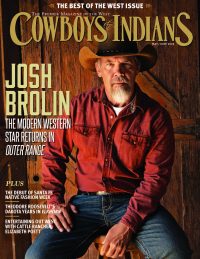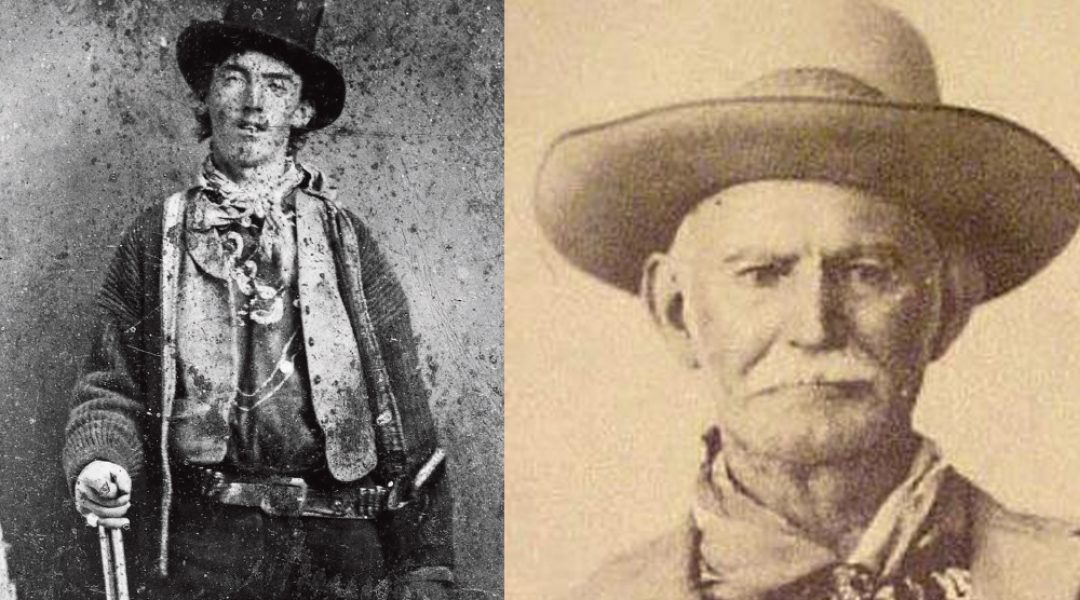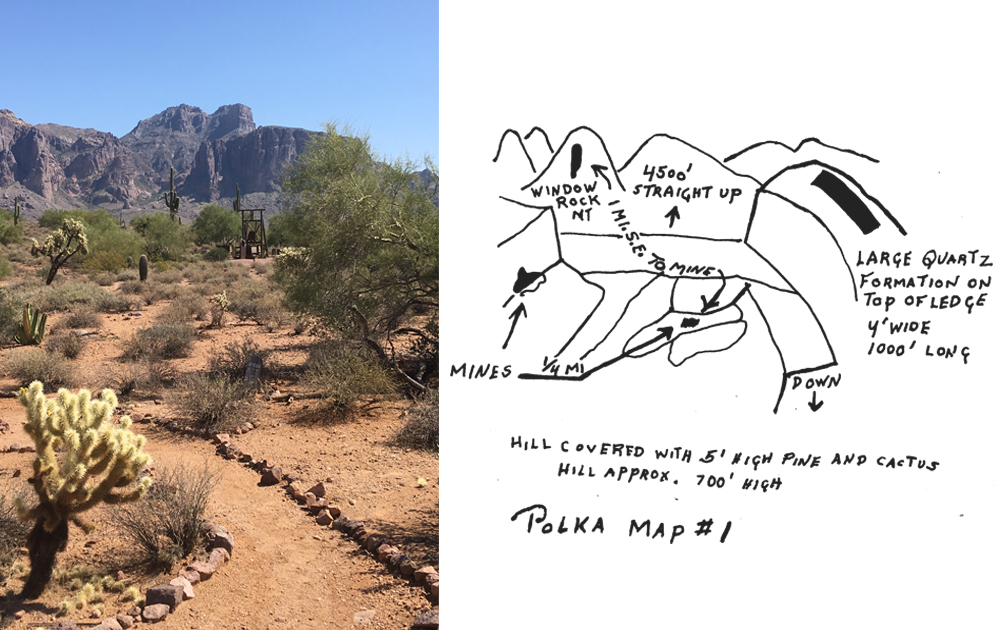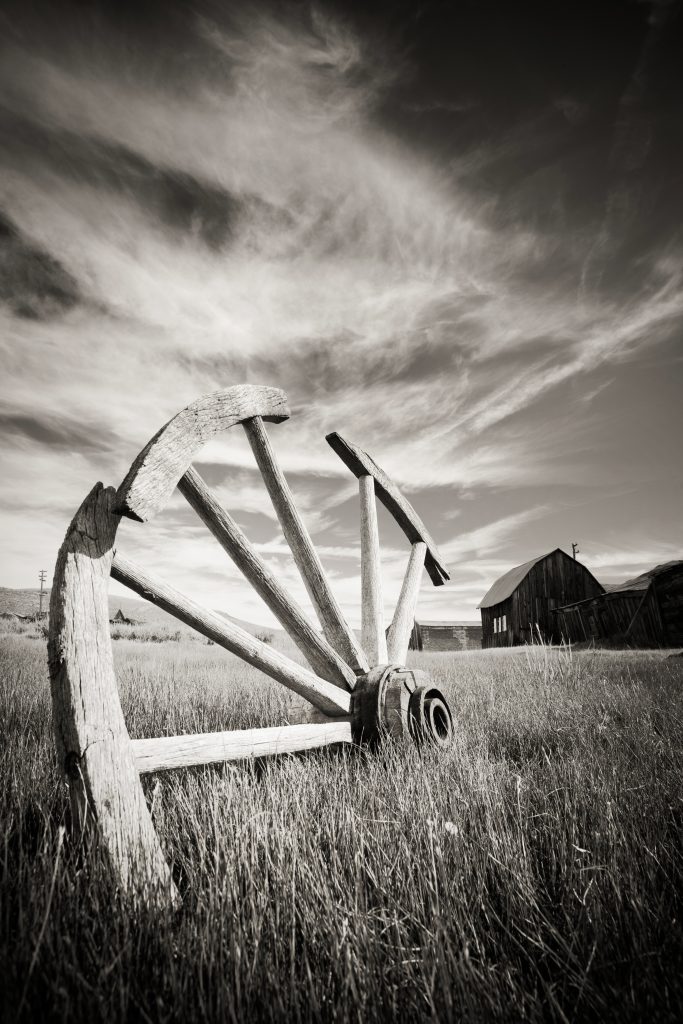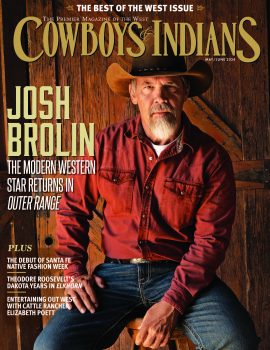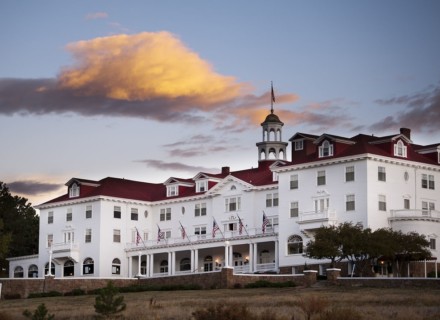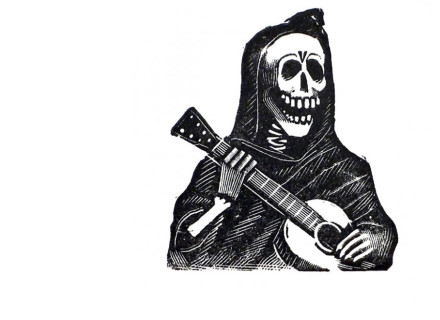Just in time for Halloween, here are 25 spooky, strange, or unexplainable tales that haunt the American West.
Oddities
1. Was Brushy Bill Really Billy the Kid?
Most historians agree Henry McCarty, aka Billy the Kid, met his end when Sheriff Pat Garrett gunned him down July 14, 1881, in Fort Sumner, New Mexico. But in 1948, an elderly Hico, Texas, man named Ollie “Brushy Bill” Roberts told a paralegal he was actually the Kid, having escaped Garrett’s posse after being wounded in a gunfight, and he wanted the pardon he’d been promised for testimony before a grand jury in 1879. Historians at the Billy the Kid Museum in Hico still maintain Roberts’ matching scars and knowledge that only the Kid could have had are proof Garrett might have passed off another man’s body as that of the ultimate Old West outlaw.
2. Elmer McCurdy, Mummified Fun House Prop
In 1976, Universal Studios crew members were moving fun house props in preparation to shoot an episode of The Six Million Dollar Man at Nu-Pike Amusement Park in Long Beach, California, when a dummy “hanging man” lost an arm, revealing human bone inside. It was the body of Elmer McCurdy, a train robber who died in a 1911 shootout and whose body went on to a more lucrative career than the hapless outlaw had in life. The corpse had first been displayed as a sideshow attraction at the funeral parlor where he was embalmed and later on the traveling carnival circuit before winding up in the fun house. He was eventually buried — under 2 cubic yards of cement — in Guthrie, Oklahoma.
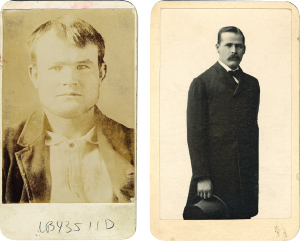 3. Did Butch Cassidy and the Sundance Kid Die in Bolivia?
3. Did Butch Cassidy and the Sundance Kid Die in Bolivia?
Pursued by law enforcement, Robert Leroy Parker and Harry Longabaugh, aka Butch Cassidy and the Sundance Kid, finally fled America for Bolivia, where they resumed their bank-robbing ways and subsequently died in a shootout on November 7, 1908. Right? Not according to several apparent witnesses who claimed Cassidy survived, altered his appearance with plastic surgery, and lived out his remaining years in Washington state. Among those witnesses? Cassidy’s own sister, Lula Parker Betenson.
4. D.B. Cooper, the Vanishing Parachutist-Skyjacker
On November 24, 1971, a hijacker calling himself Dan Cooper commandeered Northwest Orient Airlines Flight 305 with a briefcase he claimed had a bomb inside. After the plane landed in Seattle, he was delivered a ransom of $200,000 and several parachutes. Then he demanded the pilots take him to Mexico, flying low and slow, but he jumped from the jet into wilderness over southwest Washington. He was never seen again, but subsequently the FBI collected taunting letters sent to newspapers signed “D.B. Cooper.” In 2016, an investigative documentary crew named a likely suspect based on deciphered codes in the letters, but the bureau maintains the hijacker likely died during or shortly after the jump.
5. Where Is Forrest Fenn’s Hidden Treasure?
Millionaire art dealer Forrest Fenn’s self-published memoir, The Thrill of the Chase, retails for $67.99, but it could prove priceless to whoever deciphers the clues in a 24-line poem he claims is the key to finding a chest full of jewels, coins, and gold nuggets. Four people have died searching for the treasure in the Rocky Mountains, prompting Fenn to offer more specific clues. He also reminds seekers that he was about 80 when he hid it and made two trips from his vehicle — and that the search is supposed to be fun.
Update, June 2020: The hunt is over, as Fenn's treasure has been found!
6. The Lost Dutchman Mine
A fabled mine in the Superstition Mountains near Phoenix has lured treasure-seekers since German immigrant and prospector Jacob “the Dutchman” Waltz died in 1891, supposedly leaving a stash of high-grade gold ore under his deathbed after dictating to neighbors a map to a hidden mine. The promise of riches hidden in the rough terrain has resulted in a handful of deaths in the years since, as fortune hunters succumbed to heat, hypothermia, tumbles off steep cliffs, and possibly even a sniper guarding the loot.
7. New Mexico’s Seven Cities of Gold
In the 1500s, Spanish explorers in what is now Mexico heard talk about Seven Cities of Gold, or “Cibola,” hundreds of miles north, in what would become New Mexico Territory. Intrigued, Viceroy Antonio de Mendoza sent an expedition with Esteban Dorantes as its guide. They made it to the pueblo Hawikuh, where Dorantes was killed by Zuni warriors and the rest of the explorers fled. Whether his eyes had been fooled by the sun lighting up sparkling mica in the adobe pueblos or he was telling the viceroy what he wanted to hear, survivor Friar Marcos de Niza reported he’d seen a city of gold. Conquistador Francisco Vázquez de Coronado found the dusty adobe town in 1540 and was disappointed, to put it mildly.
Eerie Places
8. The Curse of Ghost Town Bodie
California’s official ghost town, Bodie, had a problem with tourists taking artifacts — ranging from nails to a piano — from the state park until word got out those stolen objects would bring bad luck. Sticky-fingered visitors have mailed back all kinds of Bodie booty — including rocks, bits of broken glass, and a bottle — with apologetic notes and stories of woe. Whether the curse is real or just a story started by a clever park ranger to prevent thefts, swiping souvenirs is probably a bad idea.
9. Ghost Lights of Marfa, Texas
On Mitchell Flat in far West Texas, mysterious dancing orbs of light have been reported outside of the artsy little town of Marfa for generations. Theories about the “Marfa Lights” range from electrostatic discharges to mirages to ghosts to UFOs. Skeptics maintain they’re the headlights and taillights of traffic on U.S. Route 67, which is visible from the area, while believers insist reports predate the highway — and the automobile.
10. Devil’s Backbone, Haunted Texas Highway
Texas Ranch Road 32 between Wimberley and Blanco runs along a ridge and offers beautiful views of the surrounding Texas Hill Country and, possibly, supernatural encounters. Locals and tourists alike tell of seeing and hearing Confederate ghost riders, mysterious lights, apparitions of a Spanish monk, and a cattle-herding Indian named Drago.
11. The Winchester Mystery House
Sarah Winchester inherited a fortune and part ownership of the Winchester Repeating Arms Company after her husband, William Wirt Winchester, died of tuberculosis in 1881. Legend had it she believed her money was cursed by the spirits of people who’d met their demise via Winchester rifles, and a psychic convinced her to move across the country and continuously build a mansion full of confusing features like doors and stairs leading nowhere to appease or baffle the ghosts. Today, much of the gigantic house and historical landmark in San Jose, California, is open to tourists, who marvel at ornate hidden spaces and stained-glass spider webs.
Hauntings and Ghosts
12. Dallas’ Lady of the Lake
A young woman in wet clothes flagged down a couple near White Rock Lake in East Dallas to plead for a ride. The couple agreed and set out toward her destination, but she disappeared during the trip, leaving behind only a damp back seat. Confused, they went to the address, described the passenger to the man who opened the door, and explained the situation. Yes, the man said, he had a daughter who looked like that — but she drowned in the lake. Dallasites have been telling versions of this tale since at least the 1930s.
13. Philmont Scout Ranch’s Tales
Some ghost stories associated with the huge wilderness hiking area owned by the Boy Scouts of America near Cimarron, New Mexico, were the invention of rangers hoping to scare hikers into taking safety precautions seriously. But long before campfire tales’ apocryphal Lost Scout could’ve hiked it, Navajo people supposedly believed the Anasazi left pictographs warning the property’s Urraca Mesa was host to an otherworldly portal, and that it was guarded by a supernatural shaman.
14. The Haunted St. James Hotel in Cimarron, New Mexico
First known as the Lambert Inn when it was built in 1872, the St. James Hotel guest rooms, saloon, and restaurant were popular with cowboys, gamblers, lawmen, and outlaws but gained such a violent reputation that “Who was killed at Lambert’s last night?” became a popular conversation-starter in the area. Several spirits are said to haunt the hotel, manifesting in ways ranging from the smell of cigar smoke or perfume and the feeling of being watched to objects being moved to apparitions of people in 19th-century attire.
15. Miss Kate’s Room at the Sheridan Inn
Not all Wild West-related hauntings are attributed to restless spirits whose earthly bodies met violent ends. The kindly spirit of a longtime employee is said to guard the historic Sheridan Inn in Sheridan, Wyoming, where guests and staff have reported inexplicable cold spots, flickering lights, and footsteps. Kate Arnold, or “Miss Kate,” worked at the hotel for 64 years, living there for most of that time, and her ashes were placed in a wall in her room — 306, which is available for guests — after her death.
16. Lower Yellowstone Falls
One of the best-known of many supernatural tales from the area today known as Yellowstone National Park is that of the Lower Falls, where in 1870 an expedition of five militiamen and a Crow guide gave chase to a small band of Native Americans who stole pack horses from the explorers. The militiamen caught up with the thieves just as they were attempting to cross the river above the falls on a thrown-together raft of driftwood. After a brief exchange of gunfire, the militiamen realized the Indians on the raft were doomed. Indeed, before they disappeared over the falls, the band’s women began wailing and the braves chanted a death song that’s supposedly sometimes heard by visitors today.
UFOs
17. The Martian Pilot Buried in Aurora, Texas
A “mystery airship” crashed into a windmill and exploded at 6 a.m. on April 17, 1897, on a farm near Aurora, Texas, according to witness accounts published in The Dallas Morning News two days later. According to the story, the ship had a single pilot, who was killed and mangled by the crash, but not so badly damaged as to prevent witnesses from deducing he was not of this world, and likely from Mars. The cigar-shaped metallic craft was estimated to weigh several tons, yet none of the debris supposedly carried away by townspeople and visitors, nor the papers the pilot carried that were “written in some unknown hieroglyphics,” nor even the gravesite have been found since.
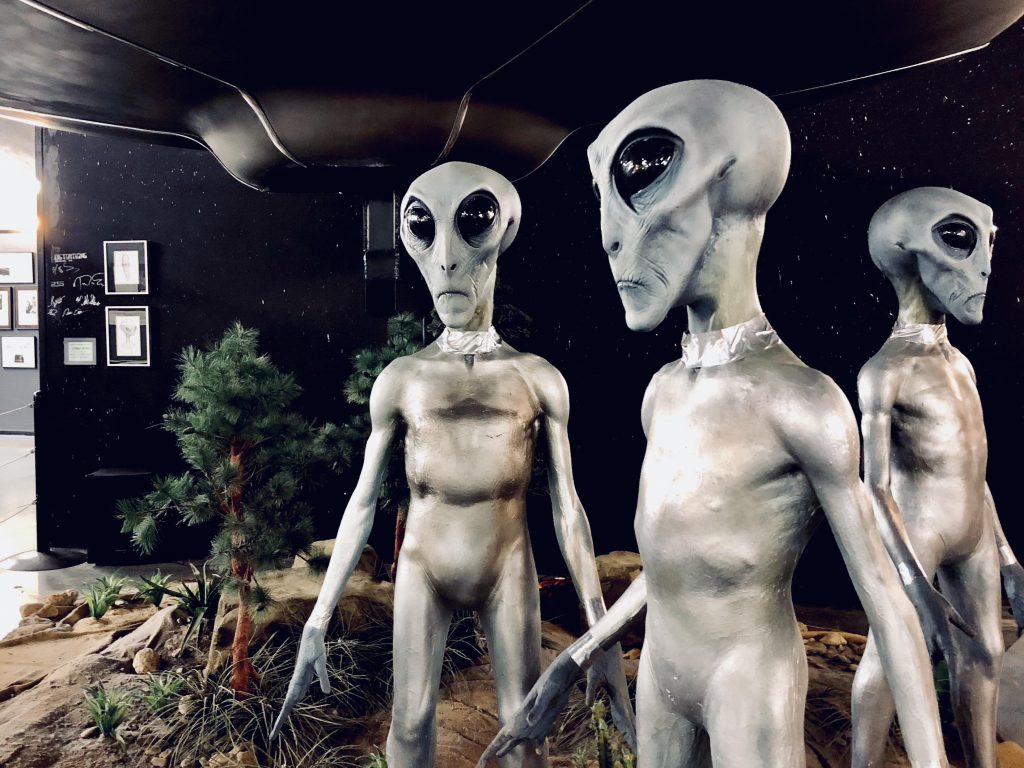 18. The Roswell Incident
18. The Roswell Incident
Confusion, a military coverup, and conflicting reports over the June 14, 1947, crash of what the military now says was a nuclear-surveillance balloon on a ranch outside Roswell, New Mexico, snowballed into a mythology that has more or less shaped the way people think about alien “flying saucers” and “little green men.”
19. World War II’s Strange Battle of Los Angeles
At 2 a.m. on February 25, 1942, a few hours after naval intelligence warned of a potential attack on the California coast — and five years before the Roswell, New Mexico, incident — military radar detected apparent enemy aircraft 120 miles west of Los Angeles. The city was darkened in a blackout, and troops manned antiaircraft guns and probed the sky with searchlights. An hour later, shooting began in Santa Monica following reports of an unidentified object in the sky. In the ensuing chaos, troops and civilians reported seeing aircraft, some describing a round floating object, but none of the machine guns or shrapnel seemed to hit their targets. Come daylight, the only damage found was from friendly fire, the only deaths from car wrecks and heart attacks. An Army document after the war identified the round objects as — you guessed it — weather balloons.
20. Area 51, the Top Secret Air Force Base
People claiming to have worked at the Military Operating Area in southern Nevada officially known as Groom Lake or Homey Airport have said the site commonly called Area 51 is the base of, variously, collaboration with extraterrestrials, storage of and experimentation with crashed alien spacecraft, time-travel research, weather control, and the base of a one-world government.
Legendary Monsters
21. The Man-Eating Windigo
One frightening monster from Native folklore is Algonquian tribes’ windigo. Afflicted with an insatiable hunger, these supernatural creatures are gaunt, skin stretched tight over their bones. Certain cultures describe them as antlered giants that grow proportionally — in size and appetite — with each victim they eat. Some traditions hold that greed can turn humans into windigos. A few 19th-century anthropologists even believed in windigo psychosis, in which a person is possessed by the irresistible need to eat human flesh. There is at least one historical example of someone claiming to have the disease: In 1879, a Cree trapper named Swift Runner was convicted of murdering his entire family after authorities found human bones broken and sucked of their marrow and a pot full of human fat at his camp. His supernatural defense didn’t stop a jury from giving him the death penalty.
22. The Skinwalker
Stories of encounters with a skinwalker, a supernatural witch or medicine man from Navajo legend, are hair-raising. A skinwalker, or yee naaldlooshii, is comparable to a witch doctor or werewolf found in other societies’ folk stories. It’s a man, or sometimes an old or childless woman, who can curse victims and transform into an animal — in some tellings, gaining these powers by killing a relative. A skinwalker usually takes the form of a trickster animal, often a coyote, but also will appear as an owl or crow, animals associated with death. But they don’t look right as animals, moving on their hind legs, appearing hollow and starved, and sometimes having humanlike hands, feet, or faces — and lifeless eyes.
23. The Gigantic Thunderbird
An enormous bird responsible for thunder and lightning is a common character in Native American myth, sometimes figuring as a godlike creature, sometimes as a shape-shifting human, sometimes as a family or clan symbol, and sometimes as simply a normal, if huge and powerful, feathered animal with no supernatural significance. One version, the Piasa, was painted on rock cliffs along the Mississippi River at Alton, Illinois, and observed in 1673 by French explorer Jacques Marquette. A re-creation of the painting is still there today. Alton is also where a father and son reported seeing a bird the size of an airplane flying at 500 feet, amid a rash of similar sightings in the 1940s.
24. Chupacabra, the Goat-Sucker
The chupacabra has been described as the “Bigfoot of Latino culture,” a legendary creature said to drain the blood of livestock. The name is Spanish for “goat-sucker.” Mysterious cattle killings and mutilations first in Puerto Rico and later elsewhere in the United States, then Mexico and around the world, have been blamed on a kangaroo-size, upright-walking scaly lizard. Other descriptions suggest something more like giant bats, and still others describe hairless canines. C&I food & drink editor José R. Ralat, who is Puerto Rican, gets goosebumps recounting his father’s tales, going back to the 1950s, that describe the sound of a large beast rustling high in the treetops at night, leaving behind clumps of fur.
25. Bigfoot
Lastly, who can forget Bigfoot? Cryptozoologists — zoologists dedicated to the study of folkloric creatures called cryptids — insist the preponderance of footprints and sightings suggest some kind of primate once lurked in the wilderness, and may still be there, hiding from mankind. Read more about Bigfoot in this October 2018 feature.
Photography: (Bodie wagon wheel) Rick Parchen, courtesy Billy the Kid Museum, courtesy Library of Congress, courtesy Superstition Mountain Historical Society, Alamy



